#ancient aegean art
Explore tagged Tumblr posts
Text
Ancient Aegean - Art History Notes
Original post link / Original post date: October 2 2023
Timeline: 3000-2000 BCE – [Aegean] – Early Cycladic Art 2000-1700 BCE – [Aegean] – Old Palace Period (Crete) 1700-1400 BCE – [Aegean] – New Palace Period (Crete) 1400-1200 BCE – [Aegean] – Mycenaean occupation of Crete 900-600 BCE – [Greece] – Geometric & Orientalizing 600-480 BCE – [Greece] – Archaic 480-400 BCE – [Greece] – Early & High Classical 400-323 BCE – [Greece] – Late Classical 323-30 BCE – [Greece] – Hellenistic
Vocabulary: Cycladic – of the islands of the Aegean Sea, including Syros, Paros, Delos, Naxos, Keros, Melos, and Thera. This excludes Crete. Minoan – art of the island of Crete. Helladic – of the mainland of Greek.
Early Cycladic Art – 2600-2300 BCE
Cycladic Art is titled as such for the Cyclades in the Aegean Sea, which includes Syros, Paros, Delos, Naxos, Keros, Melos, and Thera, among other islands. They are named the Cyclades as the other islands seem to circle around Delos. This excludes Crete. Marble was found in the Aegean islands, which gave way to the beginnings of marble statues in Ancient Greece. The Cycladic art that we still have now consists of marble statuettes, which have a distinctive abstract style to them. Two of these art pieces are the Syros Woman and Keros Musician, both of which follow a similar style of great abstraction of the human form.
Minoan Art – Crete – 1700-1500 BCE
In this period, Cretan art is referred to as Minoan Art. There are two periods of Minoan art: Old Palace and New Palace. The “Palace” in question were large structures, of multiple rooms, on the island of Crete. These were most likely centers for religion, administration, and commercial works as opposed to residents for royalty- though, we are not sure. In cases like this, we have more evidence for one idea than another, so the one with more evidence is used more. The Old Palace period ended abruptly at 1700 BCE, most likely from an earthquake, which lead into the New Palace period as reconstruction immediately began. The largest palace complexes were at Knossos, Phaistos, Malia, Kato Zakro, and Khania. These were where Minoan life took place. The largest of these palaces was at Knossos, where it was named to be the home of King Minos, labeling this palace as the home of the labyrinth of the Minotaur. It should be noted that this was given to the palace as a story as opposed to this myth happening. The English word labyrinth, however, comes from this type of floor plan used in this palace, with the intricate planning and scores of rooms. This layout, a “double ax” labrys, is reoccurring in Minoan architecture and art, representing a sacrificial slaughter. Many Greek myths were taken down generations orally and many of these stories pointed to the glory days of the times evermore ancient to the ancient Greeks; this myth is probably connected to the Minoans and their palaces while remaining a myth. These palaces were constructed very well, made of sturdy stones embedded in clay, while sporting multiple stories. As true with most Mediterranean areas surrounded by water, Crete is mountainous and rocky, so these palaces accommodated building on top of this with multiple stories that made up for the depth of the slope. Meaning, there were parts of these palaces that were four-to-five stories tall. These palaces hosted drain systems for rain water, ventilation areas to fresh air, columns to hold the weight of the structure, and light wells to bring in natural light. Their columns were notably different than Greek or Egyptian columns of the time as they tapered from top to bottom, wide to narrower. The top was wide while the base was narrower.
Frescos were used to decorate these palaces, featuring nature paintings and aspects of Minoan life. These were achieved differently than Egyptian frescos, which was fresco secco, as the Minoan frescos were the first true buon fresco. To achieve this, they covered the rougher walls in white, fine lime plaster and painted onto the plaster as it was still wet. This means that the painting became a part of the wall, but the painters had a shorter amount of time to achieve the paintings. These paintings do not follow a strict canon, as the Egyptians did, but instead featured a very lively depiction of Minoan life with a freshness in the artworks.
Cycladic Art – 1600 BCE
Other frescos have been discovered, notably on the island of Thera, in Akrotiri, in the Cyclades. These were preserved by a volcanic eruption, with the area being buried in volcanic ash and pumice, similarly to how Pompeii was preserved. These frescos, as opposed to a palace/complex, decorated the walls of shrines and houses, making their number greater. These give us a better insight to how they once could have looked and their full compositions.
Minoan Art – 1800-1500 BCE
Minoan art also featured pottery which depicted nature, particularly the sea and its creatures. These pottery pieces were the first breaths of the style that the Greeks would adopt, morphing into red-figure and black-figure pottery. The Minoans did not have life-size statues or depictions of people or pieces of mythos, having a few smaller pieces remaining. We do not know of any mythos before the Ancient Greeks. A notable art piece is the Harvesters Vase, featuring relief sculptures, while being one of the first evidences of this area of the Mediterranean having an interest in the human body and further anatomy. It’s not well known when the full decline happened of the Minoan society, but we do know that the palaces were destroyed around 1200 BCE, with the Mycenaeans occupying the area before then. The cultural significance of these palaces faded around 1400 BCE.
Mycenaeans – 1600-1200 BCE
The Mycenaeans came to the Greek mainland at about 2000 BCE, being known as warriors who might have brought their wealth from the spoils of their victories. After Cretan palaces were destroyed, the Mycenaeans were left being the surviving Greek civilization. Mycenaean is the label placed on these people, but their fortifications were found at Mycenae, Tiryns, Orchomenos, Pylos, and other areas of Greece. These people became the silent subject of Greek mythos, as their fortifications were explained by later Greeks as being made by giants. The elite in this society were buried in bee-hive shaped tombs. The burial chamber, known as a tholos, consisted of a serious of stone, corbeled courses, laid on a circular base to form a dome. They created masks and daggers for their burials. They also produced one of the only life-size sculptures of this time on the Greek mainland. They had a distinctive illustration style on their pottery, separated from the Minoans.
———
This was a way to force me to write down notes about the greater ancient Greek world. So hopefully this was a nice little overview of the world before the Greeks.
I hope you enjoyed this little overview; make sure to make time for yourself today and drink some water-
Happy travels – Annie, the crosseyed cricket.
#art#art history#greek art#aegean art#ancient greece#ancient greek art#ancient aegean art#art education#art academia#academia#dark academia#greek
3 notes
·
View notes
Text


minoan miku!! (in a mikuified minoan outfit)
___
more of my minoan art: click
#international miku#every country miku#vocaloid#hatsune miku#miku hatsune#minoan#artists on tumblr#minoan miku#greek miku#crete#kurjdraws#my minoan art#tagamemnon#its pretty stereotypical and based on the snake godess figurine (i hate the hat) but i did it so people recognize its minoan#art#bronze age aegean#AND YES ITS A GOLDEN LEEK ON HER NECK#idk the name of this thing but everybody is drwing it so i had to#brazilian miku trend#miku around the world#miku art#country miku#cretan miku#ancient greek miku#ancient miku#ancient greece#miku worldwide#my miku art
3K notes
·
View notes
Text
redid this ancient minoan piece for my art history class: the girl here has short hair which signifies youth, but shes picking crocuses which were renowned for their relief of menstrual cramps- its a coming of age piece!


#ancient history#ancient minoan#ancient greek#minoan#minoa#ancient aegean#ancient aesthetic#ancient#ancient art#art history#crocus#saffron#feminist history#female history#womens history#historical art#art#watercolor#frescoe#watercolor painting
110 notes
·
View notes
Text

Dutch Miku
#dutch miku#international miku#every country miku#vocaloid#hatsune miku#miku hatsune#minoan#artists on tumblr#minoan miku#greek miku#crete#kurjdraws#my minoan art#tagamemnon#art#bronze age aegean#AND YES ITS A GOLDEN LEEK ON HER NECK#idk the name of this thing but everybody is drwing it so i had to#brazilian miku trend#miku around the world#miku art#country miku#cretan miku#ancient greek miku#ancient miku#ancient greece#miku worldwide
98 notes
·
View notes
Text

Saffron gathering.
I wanted to try something different, but I don't know how much I succeeded. Might redo it in the far future.
References used:
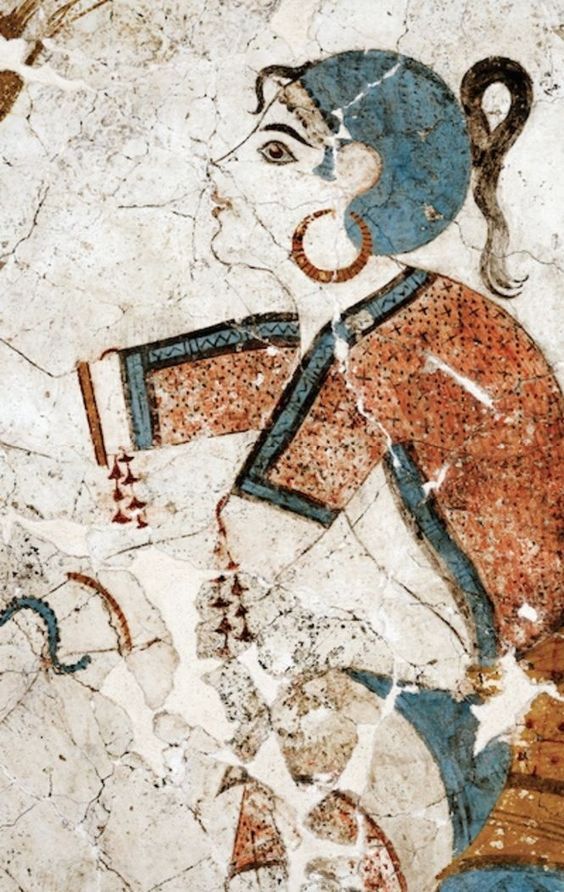
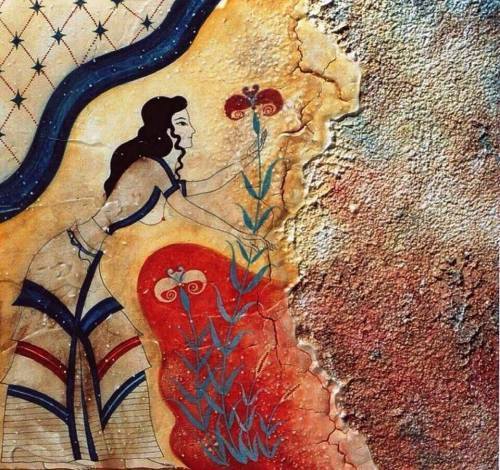
#bande dessinée#minoan women#minoan crete#minoan#minoan civilization#ancient greece#tagamemnon#bronze age aegean#bronze age#saffron#saffron gathering#saffron gatherer#digital art#artist on tumblr
24 notes
·
View notes
Text

Late Bronze Age Aegean inspired Athena
(Methodology below)
Ok, so I've taken a bit of Classical inspiration as well. I read somewhere that her Peplos was saffron and purple so I took that colour scheme and was reminded of the artwork from Pylos. This lead me to being inspired by the Battle Frieze (Pylos) for the Gigantomachy detailing in her skirt. The colour scheme for the skirt is thus tans and purples for her skirt. Minoan artwork has shown more evidence for depictions of skirts with scenes and scenery on them so that aspect is perhaps more Minoan inspired.
The bodice and the apron both are inspired from the Necklace Swinger in the Saffron Gatherers wall art from Xeste 3 (Akrotiri). I've put crocus flowers as an embroidery detailing on the bodice as it is saffron dyed. The apron takes the design from the necklace swinger as it always makes me think of the night sky (due to colours) and I figured that would make an appropriate overgarment for the story of the gods vs the giants.
The aegis is blue and gold. I chose blue because Zeus has also been associated with the aegis and I wanted to add a connection to him (blue, sky god). Blue (glass) and gold was also a popular Aegean colour decision, which can also be seen in the glass diadem (wave/bracket bead) she wears, connected to a boar tusked helmet. A blue cloak with gold tassels is also somewhat inspired by the sword wielding figure in the fresco from Mycenae's cult centre although with less tassels. I've added two glass necklaces inspired by Mycenaean glass beads. She also has glass beads in her hair, something that is seen in several female figures in Minoan and Mycenaean art.
The snake is both a tie in to the Aegean Snake Goddess but also Athena's ties with snakes (Erichthonius and Medusa both have snake and Athena links, so this may be where the Classical stuff ties in, I'm less certain on the Classics stuff).
She stands in front of an olive tree on an acropolis (meant to be the acropolis of Athens but no way to identify that so could be any).
#Athena#Athens#Greek Mythology#greek myths#tagamemnon#pagan#Hellenism#Mycenaean#Minoan#Bronze Age Aegean#Greece#Aegean#Ancient Greece#archaeology#classics#my art
29 notes
·
View notes
Text

A chariot with charioteer and rider, followed by two walking figures. Fragment of a Mycenaean krater (mixing-bowl) by an unknown artist; ca. 1400-1350 BCE (Late Helladic IIIa1). Found in Tomb 67 at Enkomi, Cyprus; now in the British Museum. Photo credit: Zde/Wikimedia Commons.
#classics#tagamemnon#Ancient Greece#Bronze Age#Aegean Bronze Age#Mycenaean#Mycenaean Greece#Cyprus#Ancient Cyprus#art#art history#ancient art#Greek art#Ancient Greek art#Bronze Age art#Mycenaean art#Cypriot art#vase painting#krater#British Museum
186 notes
·
View notes
Text


#the odyssey along with the Iliad are The literary works that ancient greek culture-- arts worldview cosmology morality-- developed around#as well as works that created the idea of a greek identity and an aegean/mediterranean history from the fragmentary traditions and memories#of the bronze age and earlier that managed to survive through the fucking dark age#if chaucer and the bible had a baby that's how important these works were for greek identity and understanding of themselves and the world#the odyssey on it's own is an incredible preservation of regional folk tales and trickster culture heroes#and a priceless glimpse into ancient greek understanding of their past as well as the political and social structures of the archaic period#and also an incredibly pioneering narrative structure that mimics the circular travels of its protagonist with its non-linear format#if a forgettable children's book series that doesn't even represent the mythology well is That for you then you need help frankly#and if it's not then shut up about it already#(just say you're a 28 year old with a 4th grade reading level and go)#like I dislike these books for a variety of reasons but it's takes like this that make me HATE them#SHUT UP about these GODDAMN BOOKS#greek mythology#ancient greece#anti pjo#anti percy jackson#lore and more
15 notes
·
View notes
Text
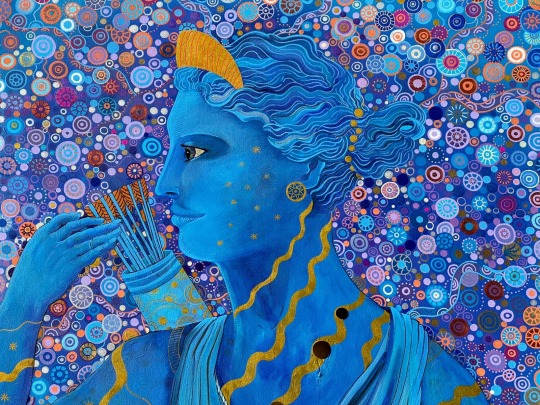
Hello everyone! I just got back from the island of Samos, Greece, and remembered that I have this painting of Artemis with Arrows still available for sale. 😊💙🌀🌀🇬🇷

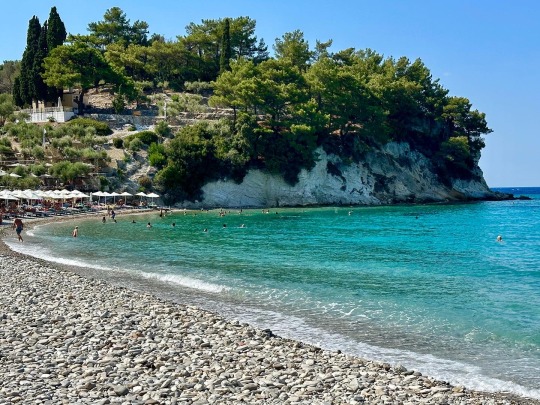


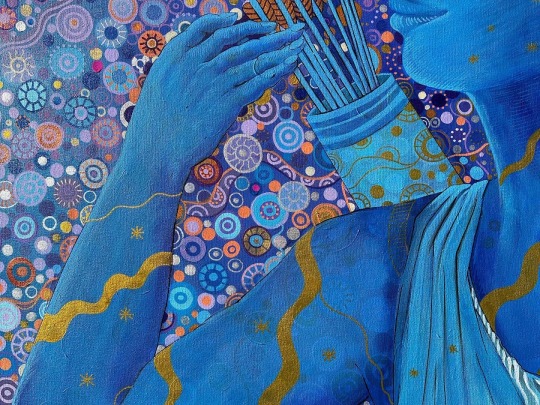



#kamaarts#kamilawojciechowicz#kamila wojciechowicz-krauze#polish artist#artemis#Diana#Greek goddess#Greece#Ancient Greece#artemida#the huntress#painting#samos#samos island#aegean island#Greek island#greek myth art#Greek mythology
4 notes
·
View notes
Text
I've read through some of Dr. Jones' documentation and summary of her book- and .. this is lovely work! However; on the whole, it feels like a 'wide artistic interpretation' based on an artistic interpretation of the primary source. These reproduction fabrics seem far too heavy and dense.
The more I study and learn about ancient textiles the more convinced I am that ancient people had many resources and techniques that are NOW LOST to us. I believe their woven fabrics were more sheer, more fine, and more durable than we can create with modern looms and modern materials.
Recreation is fun! and Experimental Archaeology is a necessary approach to understanding! check this out:
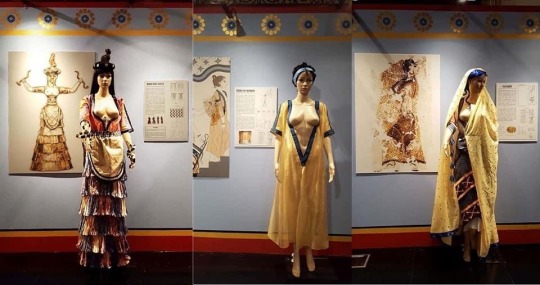

Reconstruction of the clothes of women from the Minoan era in Crete (reconstructions made by Dr. Bernice Jones).
The clothes of Minoan women were surprising with their style and variety of patterns. Greek women of later times wore clothes with completely different stylistic solutions. The exposed breasts were a characteristic feature of the dress of Minoan and Mycenaean women. They attached great importance to their attire, wear and used jewelry. They wore a wide and long skirt with a decorative belt tightening the waist and a tight-fitting bra with a metal frame revealing the breasts. They put on coats or capes on cooler days. Hair, intricately combed, was decorated with brown or gold ribbons, beads or headbands. Others wore appropriate headgear. They wore unusual hats. Some were wide, while others were tall, almost completely covering their hair, decorated with feathers or ribbons.
It can be seen at the Hellenistic Museum in Melbourne, Australia. The reconstructions are based on frescoes.
Photos: Tahney Fosdike.
#ancient Aegean textiles#loom woven#textile arts#ancient people had technology#Minoan#mycenaean#textiles history#weaving#whole cloth#i'm skeptical of a few of these recreations but I love that they exist!#bronze age#archaeology#experimental archaeology#international fibre nerds#historical reenactment
22K notes
·
View notes
Text
The Art of Greek Vase Painting
Greek vases and pottery was well-known for its quality and was widely exported throughout the Mediterranean. The techniques used by ancient Greek ceramists required thorough shaping and decorating processes that were the result of years of training under master potters. The Vase – Making Process: From Clay to Form The techniques Greek ceramists used to shape and decorate fine vases required…

View On WordPress
#aegean#ancient#Ancient crafts#ancient greece#Ancient pottery#Ancient skills#Ancient techniques#Ancient workshops#ancient world#appreciation#Archaeological#Archaeological discoveries#Archaeological finds#Archaeology#art#Art appreciation#Art craftsmanship#Art documentation#art history#Art preservation#Art signatures#Art techniques#artifacts#artisans#Artistic achievements#Artistic Expression#Artistic Heritage#Artistic Innovation#Artistic legacy#Artistic pride
1 note
·
View note
Text
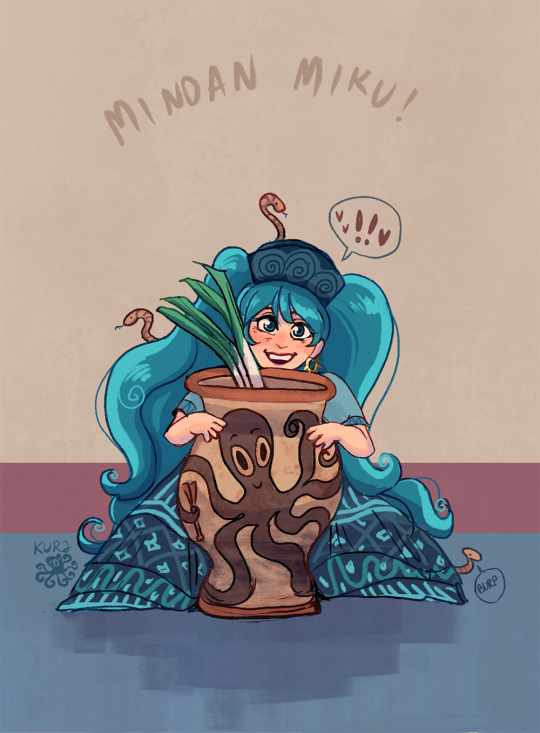
she loves her octopus jar!!
i had to draw her again lol - here's my first drawing of her (click) and more of my minoan art (click)
#minoan#minoan miku#hatsune miku#international miku#every country miku#vocaloid#greek miku#miku hatsune#artists on tumblr#crete#kurjdraws#my minoan art#tagamemnon#art#bronze age aegean#brazilian miku trend#miku around the world#miku art#country miku#cretan miku#ancient greek miku#ancient miku#ancient greece#miku worldwide#octopus vase#octopus jar#oof i hate tagging#snakes#the snake is burping#sorry for quality it was supposed to be a doodle
2K notes
·
View notes
Text
Minoan Kilt
The large, structural skirt worn by Minoan women in art is instantly recognizable, and when I made my own I combined current best guesses with my own personal tastes.

My kilt shape follows the hypothesis laid out by Bernice Jones in her book Ariadne's Threads: The Construction and Significance of Clothes in the Aegean Bronze Age. She describes the shape of that of a labrys, a double-headed axe with apparent ceremonial significance in Ancient Minoan culture. This garment may be depicted in Linear-B logogram *166 + we, we-being the backwards-s-shaped squiggle in the center which identifies the piece as a garment.

See pages 336 and 341 in Marie-Louise B. Nosch, The Textile Logograms in the Linear B Tablets
Actual details on construction and materials below the cut:
Construction:
The top and bottom edges of the kilt are concave, so the sides are longer than the middle. This gives the chevron-shape seen on layered kilts in art. In addition, the curved top half makes the skirt flare out, accommodating the hips and giving more freedom of movement to the legs. My kilt measured from my waist to my anklebone at the longest point, and about 1.5 times around my waist.
I chose to make a flounced kilt, with smaller strips of fabric and trim applied to a large base piece, rather than a tiered kilt, in which multiple kilt shapes of varying length are layered one on top of the other, so you end up wrangling 3 layers of fabric around the waist. The flounced kilt saves fabric and gives you a lot more freedom with whatever trim you might want. Jones' diagram for a flounced kilt is seen below:

Unlike the version in the diagram above, I chose not to attach ties to the garment itself both because the linen I used was very heavy and I was concerned about weight, and also because folding the skirt and securing it with a separate tie worked just fine for my tastes. In total I had four flounces: 2 alternating rows each of fabric and fringe.
The vertical edges of most kilts are left plain, probably representing either the selvage or an edge otherwise finished off to prevent fraying. For my kilt, however, I ended up with a couple inches of self-fringe on either side as I adjusted the fabric to the correct width. At least three examples of kilts with fringed vertical edges are known, all three from the so-called "House of the Ladies" in Akrotiri
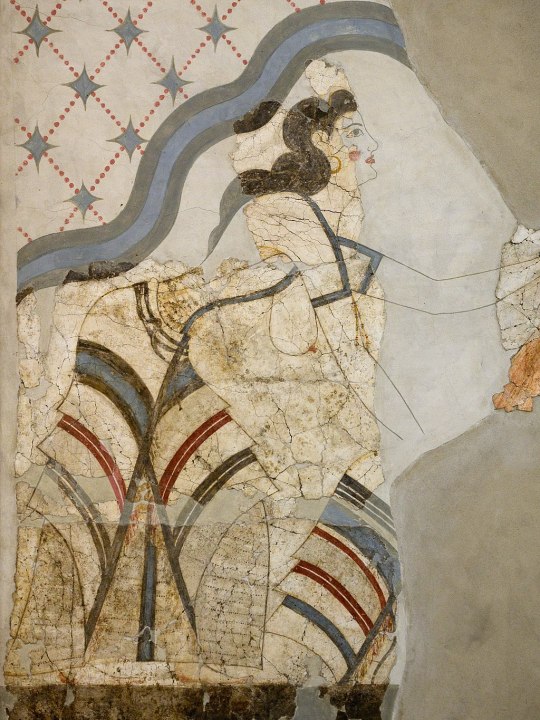

Photos from Wikimedia Commons. Image 1. Image 2.
The vertical edges of these kilts are reinforced with a colored band or tape, probably to keep the garment from unintentional further fraying. Accordingly, I did the same on my kilt. I also like that it gave a nice vertical diagonal to counterbalance the horizontal ones.
Materials
I tried to use mainly linen and wool, the fibers most available on Ancient Crete, but some of my trim was cotton because sometimes you just have to use what's cheap and available in the today times.
The base of my kilt is a heavy, patterned linen in what's called a diaper weave, meaning that a repeating diamond pattern is woven into the pattern itself. A lot of the Minoan textiles depicted in frescoes are characterized by repeating geometric patterns, likely woven into the fabric itself, and that was something I wanted to capture in my own piece. My linen is woven with both cream and natural colored threads. The heavy weight is important to give structure to the garment--otherwise it would be kind of limp. My linen was from Burnley & Trowbridge (shameless plug), as was the plain cotton twill tape I used to bind the top and bottom edges of the kilt, and the dark red wool twill tape I used along the vertical edges.
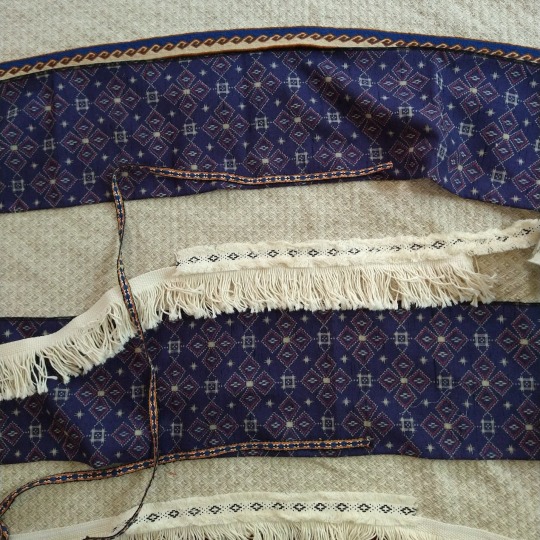
I bought my cotton fringe from a rug supply store. I had to search a while to find a fringe that would work for me, and I ultimately chose fringes with a woven header rather than the more common knotted one, so that it would lay flat against the kilt. I hid the woven header under a layer of cotton fringed trim from Michaels (yes, Michaels) with this really great diamond and dots pattern woven in black.
The blue layers are from a bolt of vintage wool Kimono fabric. Blue appears frequently in frescoes, likely achieved with indigo or woad dye, or even murex/mollusk dye. The fabric is printed with an imitation ikat pattern of diamonds and squares that made me think "the vibes seem right!" because quite frankly, you aren't going to get "historically accurate" Minoan textiles (which there probably isn't enough archaeological evidence to definitively describe) without, like, hand-weaving it yourself or paying someone hundreds of dollars to do it for you (and that price is if the weaver really likes you). Neither of which appealed to my desire to just make a fun, low stress project. Good enough is good enough.
The narrow trim on the bottom of the blue flounces is vintage cotton/poly woven trim. This trim, while narrow, was quite thick and stiff, which was great because it added more weight and structure to the end of my flounces since the wool fabric itself was quite thin.
The top layer is a custom tablet-woven wool trim that I commissioned from MAHTAVAhandicraft on Etsy. I imagined this as the "centerpiece" of my kilt, and I'd arrange everything to complement it.
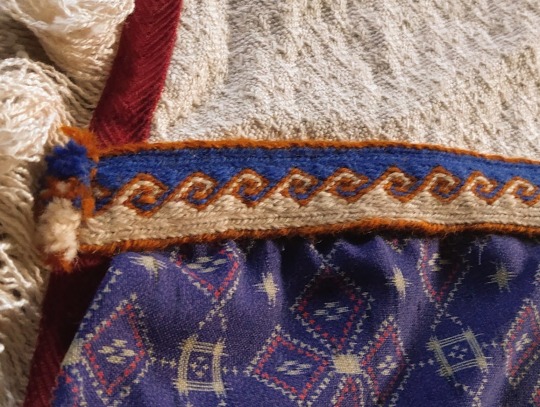
It's a kivrim pattern, which has itself only been traced to 19th-century Anatolia, but I didn't care. The way it looks like waves reminded me of how central the sea was to life in the Ancient Aegean and Mediterranean and it captured the idea and aesthetic I was pursuing. I mean, doesn't it remind you of these dolphins?

(I like the dolphins)
The whole thing was machine sewn with the exception of hemming and adding trim to the blue flounces. If you were to look at it from the back, you'd see lots of zigzag stitches, because i wanted to be fast! and have fun! not chase some unreachable ideal of "accurate."
As for wearing it, I chose to wear it with the top part folded/rolled down over a belt, so I have a thick tube of fabric around my waist. Many images, like the frescoes above of women with fringed kilts, appear to just show the kilt being tied closed. Other images are so fragmented or stylized that it's unclear what kind of skirt closure was used. Sculptures and figurines definitely show some kind of SOMETHING around the waist, whether this is folded fabric or a kind of belt is unclear. Different art could show different things!
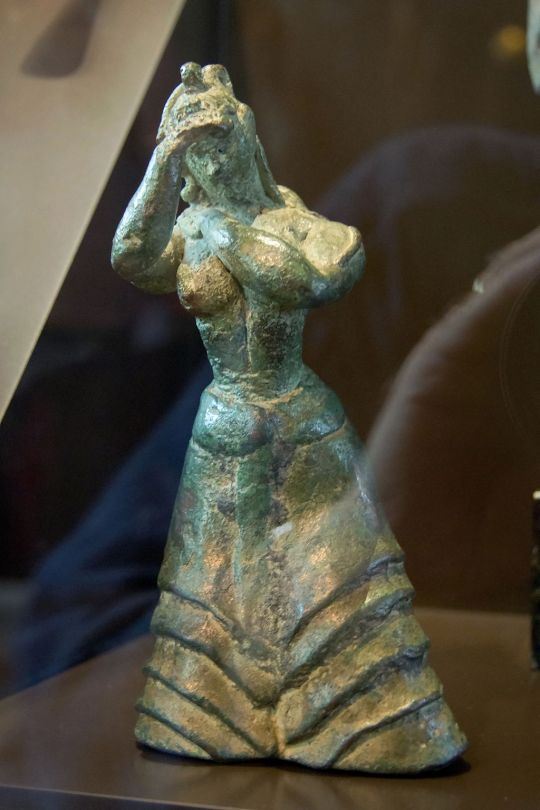
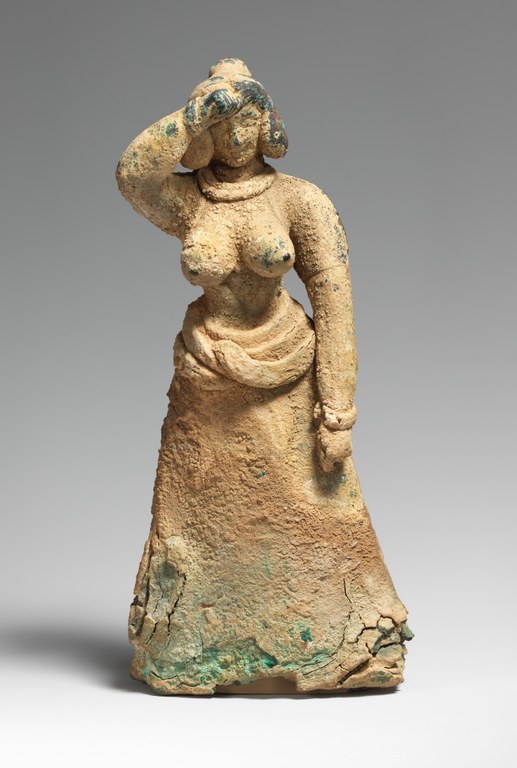
I think I see evidence of a continuous line from the skirt to the waist-roll on the figure on the left, found in Troas, which I think indicates some kind of skirt-folding situation. The woman on the right, found in Crete, looks more like she's wearing some kind of long coiled belt, or perhaps snakes. Who knows? I don't! For my own part, I found the combination of rolled waist + tie belt the most secure for doing things like kneeling, stomping around, and wading into rivers to rescue bees. I also liked that it gave me the bulk around the hips that gives Minoan figurines such a powerful silhouette, and proportionally gives more of an hourglass shape. If you wanted to do something more firmly grounded in the sources, stick just with the waist tie or belt, wrapped around a couple times and tied in back. If you want to be like me, just say "well we don't KNOW it didn't happen" and just do whatever you want. Have fun! Whatever happens, it should be fairly easy to move around in the kilt--this is not a restrictive garment, just a heavy one.
861 notes
·
View notes
Text

Scottish Highland Miku
#Scottish Highland Miku#international miku#every country miku#vocaloid#hatsune miku#miku hatsune#minoan#artists on tumblr#minoan miku#greek miku#crete#kurjdraws#my minoan art#tagamemnon#its pretty stereotypical and based on the snake godess figurine (i hate the hat) but i did it so people recognize its minoan#art#bronze age aegean#AND YES ITS A GOLDEN LEEK ON HER NECK#idk the name of this thing but everybody is drwing it so i had to#brazilian miku trend#miku around the world#miku art#country miku#cretan miku#ancient greek miku#ancient miku#ancient greece#miku worldwide
62 notes
·
View notes
Text

Young girl gathering saffron and goddess or woman of authority flanked by blue monkey on left and griffin to right, based a fresco, circa 1600 BCE, Xeste 3, Room 3, North Wall, Akrotiri archaeological site, Santorini, Greece.
Some archeologists claim that the woman (on the left) whom the girl on the right gathers saffron for is actually a religious deity (hense the monkey and the griffin) and that the girl has an epiphany, marking her transmission from a young virgin to a full adult.
References (and uncensored version) used below:
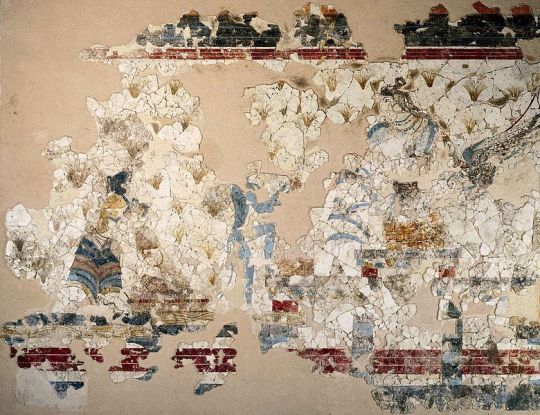

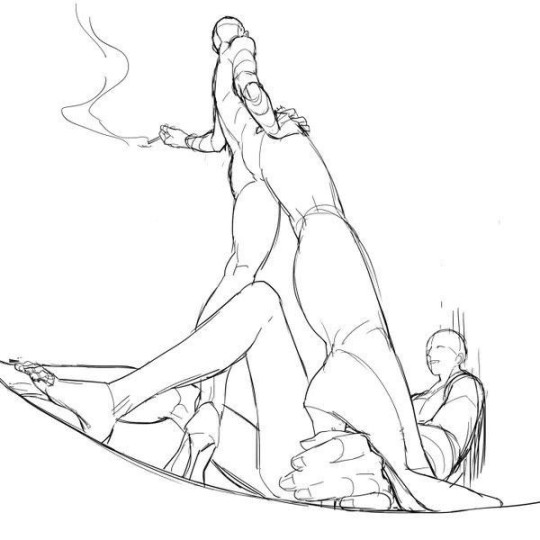

#tagamemnon#ancient greece#greece#greek history#artist on tumblr#crete#ancient crete#minoan#minoan civilization#minoan women#minoan crete#monkey#griffin#saffron#saffron gathering#digital art#bronze age#bronze age aegean
22 notes
·
View notes
Text
the way that i fully forgot to actually add the poem
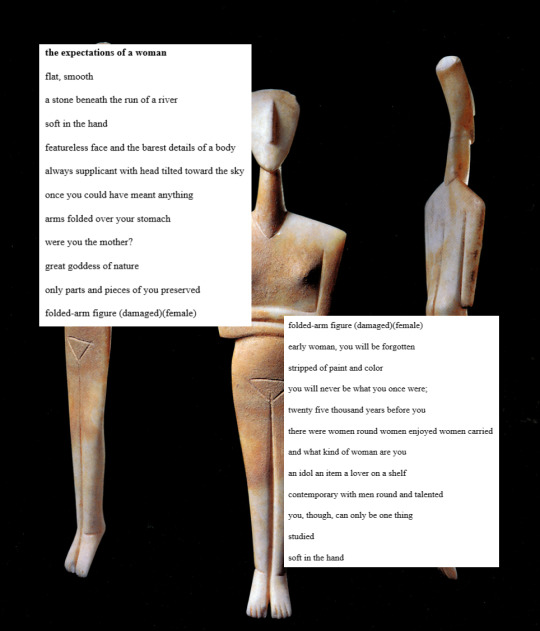
who wants to see the poem i wrote for class (art history survey 1) twelve days before i have to turn it in
8 notes
·
View notes